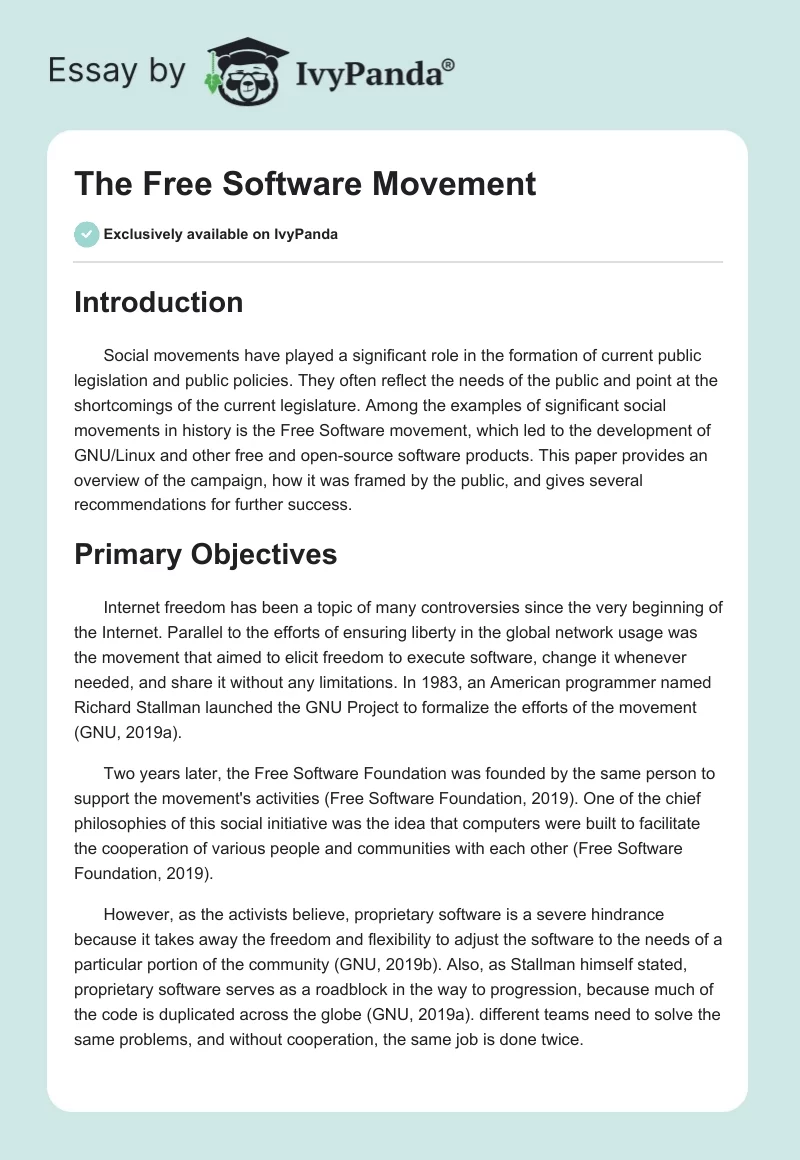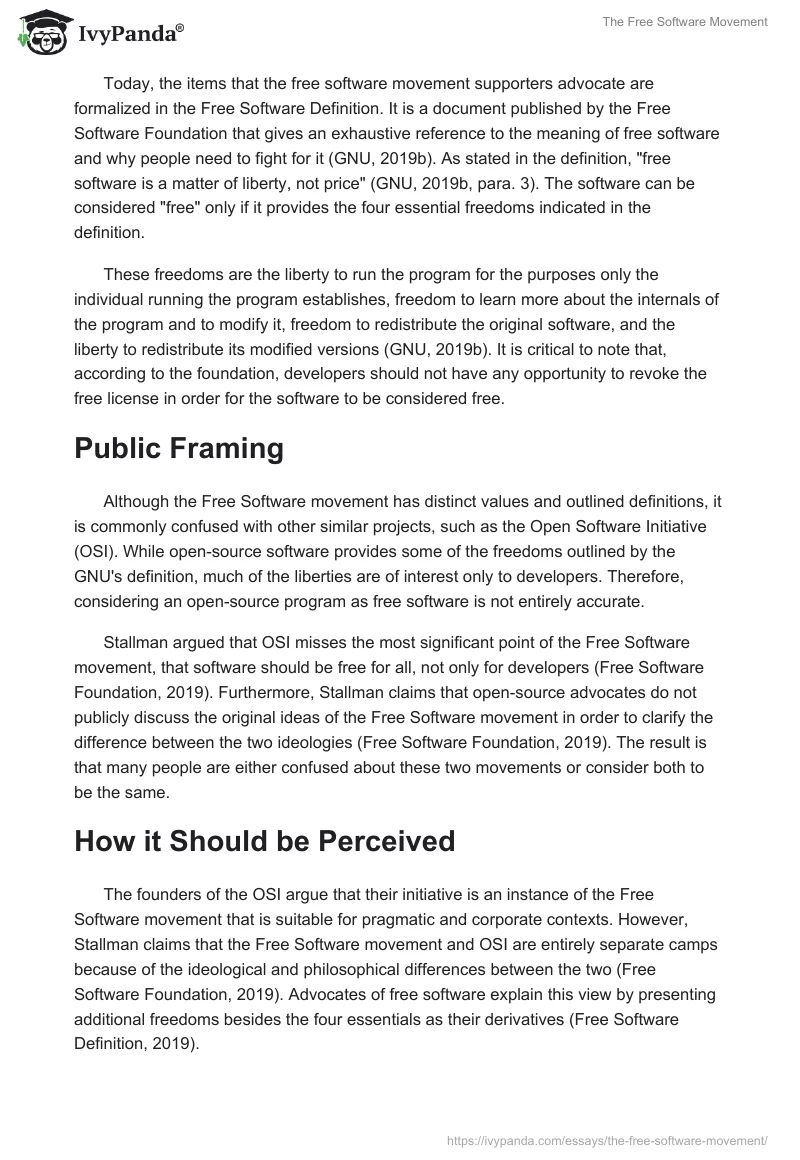Introduction
Social movements have played a significant role in the formation of current public legislation and public policies. They often reflect the needs of the public and point at the shortcomings of the current legislature. Among the examples of significant social movements in history is the Free Software movement, which led to the development of GNU/Linux and other free and open-source software products. This paper provides an overview of the campaign, how it was framed by the public, and gives several recommendations for further success.
Primary Objectives
Internet freedom has been a topic of many controversies since the very beginning of the Internet. Parallel to the efforts of ensuring liberty in the global network usage was the movement that aimed to elicit freedom to execute software, change it whenever needed, and share it without any limitations. In 1983, an American programmer named Richard Stallman launched the GNU Project to formalize the efforts of the movement (GNU, 2019a).
Two years later, the Free Software Foundation was founded by the same person to support the movement’s activities (Free Software Foundation, 2019). One of the chief philosophies of this social initiative was the idea that computers were built to facilitate the cooperation of various people and communities with each other (Free Software Foundation, 2019).
However, as the activists believe, proprietary software is a severe hindrance because it takes away the freedom and flexibility to adjust the software to the needs of a particular portion of the community (GNU, 2019b). Also, as Stallman himself stated, proprietary software serves as a roadblock in the way to progression, because much of the code is duplicated across the globe (GNU, 2019a). different teams need to solve the same problems, and without cooperation, the same job is done twice.
Today, the items that the free software movement supporters advocate are formalized in the Free Software Definition. It is a document published by the Free Software Foundation that gives an exhaustive reference to the meaning of free software and why people need to fight for it (GNU, 2019b). As stated in the definition, “free software is a matter of liberty, not price” (GNU, 2019b, para. 3). The software can be considered “free” only if it provides the four essential freedoms indicated in the definition.
These freedoms are the liberty to run the program for the purposes only the individual running the program establishes, freedom to learn more about the internals of the program and to modify it, freedom to redistribute the original software, and the liberty to redistribute its modified versions (GNU, 2019b). It is critical to note that, according to the foundation, developers should not have any opportunity to revoke the free license in order for the software to be considered free.
Public Framing
Although the Free Software movement has distinct values and outlined definitions, it is commonly confused with other similar projects, such as the Open Software Initiative (OSI). While open-source software provides some of the freedoms outlined by the GNU’s definition, much of the liberties are of interest only to developers. Therefore, considering an open-source program as free software is not entirely accurate.
Stallman argued that OSI misses the most significant point of the Free Software movement, that software should be free for all, not only for developers (Free Software Foundation, 2019). Furthermore, Stallman claims that open-source advocates do not publicly discuss the original ideas of the Free Software movement in order to clarify the difference between the two ideologies (Free Software Foundation, 2019). The result is that many people are either confused about these two movements or consider both to be the same.
How it Should be Perceived
The founders of the OSI argue that their initiative is an instance of the Free Software movement that is suitable for pragmatic and corporate contexts. However, Stallman claims that the Free Software movement and OSI are entirely separate camps because of the ideological and philosophical differences between the two (Free Software Foundation, 2019). Advocates of free software explain this view by presenting additional freedoms besides the four essentials as their derivatives (Free Software Definition, 2019).
Among the most prominent is the freedom to control the software an individual is using. Looking at a source code that is published on some websites is not sufficient to prove the software to be free. When software is deployed by a provider of the service, it is not possible to see what changes were made to the open-source software until being deployed. A user has no power to see whether the provider is using the software to spy over the individual. Therefore, OSI is only a methodology of collaboratively working on software, but Free Software is a social movement that goes beyond software engineering methodologies.
Impact So Far
The success of the Free Software movement has only been partial, but even these results can be considered substantial because of the ideologies scale. In some countries, lobbying is done to prohibit software patents, and some governments only use free software for operating and maintaining their information systems and infrastructures (McKimmy, 2017). For instance, there is a law in Uruguay requiring all government agencies to exchange information through open data formats instead of using proprietary constructs, such as PSD (McKimmy, 2017).
In the United Kingdom, the government provides a partial list of components that were used when developing its digital systems (McKimmy, 2017). This list can be used by individuals to see what to expect from using the government’s software. Much of the freedom is not provided, however, because the software’s owner retains the control to exercise power over users.
The vast majority of companies and governments use proprietary software, such as Microsoft Windows and Microsoft Office. That is either because of ignorance of software freedom or because of the fact that a significant portion of free software lack quality and important features. GNU, along with the Free Software Foundation, is working tirelessly to bring essential programs and utilities to their operating system in the free form (GNU, 2019a). It is significant to mention that free software is costly to develop, and any product needs public funding in order to be usable and feature-rich.
It is interesting to admit that the Free Software movement’s influence has been more significant for the opposition of oligopoly in scientific publishing. Usually, scientists present their papers to private companies for publishing (Setenareski, Shima, Sunye, & Peres, 2016). However, affected by the ideology of the Free Software movement, some scientists started contributing to open repositories and providing review services to alternative scientific work hubs (Setenareski et al., 2016). The end result is that contemporary search engines, such as Google and Bing, provide links to open repositories that contain free scientific papers (Setenareski et al., 2016). It should be noted that the word “free” in this context relates to the price rather than the freedom to modify. The ownership solely belongs to the authors of the papers.
Recommendations for Advancement
The activities of the Free Software movement have been limited to writing free software and increasing public awareness. However, the confusion about the difference between open-source software and free software has posed a hindrance to marketing the ideas of the movement effectively. Instead of trying to argue with other initiatives on the meaning of free software, the campaign has to position itself as the advocate of a common-ground philosophy that is partially shared by various other actions. For instance, the majority of open-source programs can be considered free even by the standards of the Free Software Definition.
As was mentioned, OSI is a methodology, but Free Software is a broad philosophy. However, these intricacies are not yet perceived by the general public because the Free Software movement sees its relationship with OSI as conflicting rather than its partial derivative. These internal disagreements have to be eliminated if the leaders want the ideas of the movement to be accessible by all people.
Conclusion
In summary, the Free Software movement should be viewed as an ideal standard that is partially or fully implemented by practical initiatives, such as OSI. In the capitalistic world, it is fair to believe that it is impossible to make all software free. The laws of economics state that there will always be parties that act solely in their own interests, and providing software for free is rather altruistic than selfish. Despite internal conflicts in the free software community, the movement is an important initiative towards liberal software.
References
Free Software Foundation. (2019). Free software. Web.
GNU. (2019a). Free software movement. Web.
GNU. (2019b). The free software definition. Web.
McKimmy, P. (2017). Free software and open source movements: From digital rebellion to Aaron Swartz – Responses to government and corporate attempts at suppression and enclosure. Web.
Setenareski, L. E., Shima, W., Sunye, M., & Peres, L. (2016). Open digital repositories – The movement of open access in opposition to the oligopoly of scientific publishers. Web.


